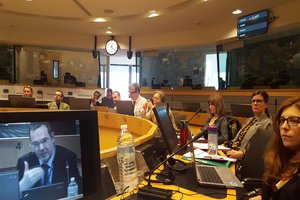News
Towards a new European legal tool: the ECBC
March 2018
The intergovernmental working group on innovative solutions to cross-border obstacles met for the sixth time on 6 February 2018. It is working on the proposal for a new European tool dedicated to cross-border cooperation: the European Cross-Border Convention (ECBC).
Initiated by Luxembourg and France (General Commission for Territorial Equality) and coordinated by the MOT, the group was set up during meetings of directors of spatial planning and urban policy in May 2016 under the Dutch presidency. Its mandate was renewed in Tallinn in December 2017.
During its presidency of the EU Council (second half of 2015), the Grand Duchy of Luxembourg highlighted cross-border cooperation issues and the need to resolve obstacles to cooperation. A study on legal solutions to overcome obstacles to cross-border cooperation was then entrusted to the MOT, with the remit to examine the need to change the law and envisage new legal tools.
At European level, the assessment was made, through the "Cross-Border Review" conducted by DG REGIO in 2015-17, that the majority of obstacles to cross-border cooperation are of a legal or administrative nature.
Given the coexistence of different legal systems on either side of a national border, Luxembourg proposed a new European legal tool known as the European Cross-Border Convention (ECBC), which would make it possible, in the case of a territorially circumscribed cross-border infrastructure or service (e.g. a hospital or tramline), to apply the standards of one of the two countries.
The idea is to enable local players to trigger a procedure whereby a request is made to the national authorities concerned, which would then have to provide a response, within a given timeframe, to resolve the cross-border obstacle in question – either adapting the legal provisions blocking the project, or concluding an agreement covering their shared areas of competence (e.g. a cross-border public service), choosing to apply just one of the national normative frameworks concerned. This tool, based on the principle of mutual recognition, would allow local players to propose a solution that national governments would either validate or not following a simpler procedure and within a shorter timeframe
The working group is assisting with the technical and legal development of the ECBC tool, notably by examining concrete examples of obstacles where the tool could be of real benefit and scenarios for triggering the procedure. The aim is to raise awareness about the obstacles that persist in cross-border territories and the usefulness of such a mechanism in removing them. In the wake of tools like Interreg and the EGTCs, the ECBC thus constitutes one of the future avenues for cohesion policy post-2020.
DG REGIO is currently working on a draft regulation, which still needs to be discussed and validated within it and with the Commission's other departments.
So far, the working group has made it possible to present the initiatives undertaken by players involved in cross-border cooperation to overcome obstacles. This forum for discussion has looked at the experiences of Cerdanya Hospital, the Nordic Council, the Benelux, the Estonia-Latvia intergovernmental commission, and the MORO pilot projects along Germany's borders, etc.
The working group will continue to meet in the coming months to discuss the different national contexts and promote the draft regulation, in particular pursuing its actions to communicate about the tool's benefits to representatives of Member States. It will support DG REGIO's initiatives concerning cross-border cooperation within the framework of the communication "Boosting growth and cohesion in EU border regions", the online platform, the resource library, the call for proposals for pilot actions, and cross-border observation, etc.
All of the contents of the working group's meetings (presentations, minutes) are available on the MOT's website, in both French and English. Click here.
Back to list
